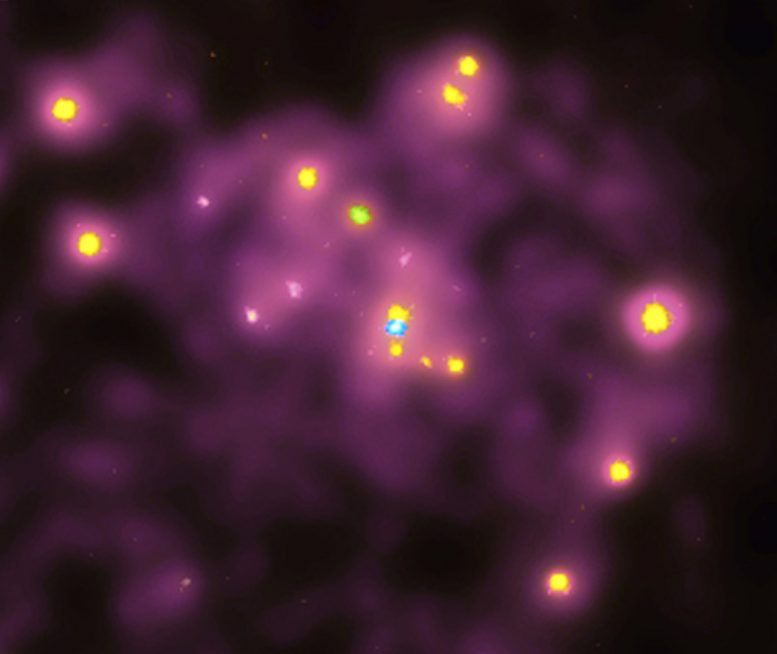
A tiny fraction of the x-rays in this image of the central area of the Andromeda galaxy—obtained with NASA’s spaceborne Chandra X-ray Observatory—could originate from dark matter. Credit: NASA/CXC/SAO
Two new studies report that X-rays emanating from the hearts of nearby galaxies and galaxy clusters could be signs of particles of dark matter decaying in space.
X-rays of a specific wavelength emanating from the hearts of nearby galaxies and galaxy clusters could be signs of particles of dark matter decaying in space, two independent teams of astronomers report. If that interpretation is correct, then dark matter could consist of strange particles called sterile neutrinos that weigh about 1/100 as much as an electron. However, some other researchers are skeptical.
For decades, astronomers and astrophysicists have thought that some sort of mysterious dark matter must provide the gravity that keeps individual galaxies from falling apart. In fact, the current standard model of cosmology indicates that a typical galaxy forms within a vast clump, or halo, of dark matter whose gravity keeps the stars from flying out into space. However, scientists do not know what dark matter is, as they have never detected it by any means other than sensing its gravity.
Now, two teams report possible signs of dark matter particles revealing themselves in another way—by very, very slowly decaying into normal photons. Both groups relied on data from one of the most successful space observatories, the European Space Agency’s X-ray Multi-Mirror Mission (XMM-Newton), which launched in December 1999 and is still taking data. Esra Bulbul, an astrophysicist at the Harvard-Smithsonian Center for Astrophysics in Cambridge, Massachusetts, and colleagues discovered x-rays of a specific energy—3.5 kiloelectron volts (keV)—shining from 73 galaxy clusters, including the Perseus cluster. The Harvard group also used data from NASA’s orbiting Chandra X-ray Observatory launched by NASA in July 1999, as it reports in a paper submitted to The Astrophysical Journal.
Working independently, Alexey Boyarsky, a theoretical physicist at the Leiden Observatory of Leiden University in the Netherlands, and colleagues focused on the Andromeda galaxy and on the Perseus galaxy cluster, where they found such x-rays as well, as they report in a paper submitted to Physical Review Letters.
X-rays of that energy do not correspond to any known X-ray “line” that could come from the ordinary excitation of atoms, the researchers say. “We could not match it with anything that would come from a thermal plasma,” says Maxim Markevitch of the NASA Goddard Space Flight Center in Greenbelt, Maryland, and a member of Bulbul’s group.
Those unexplained X-rays could come from dark matter particles. In the 1990s, some theorists speculated that dark matter could consist of some kind of “sterile neutrino,” a particle akin to the three types of neutrino that can be generated in the collisions of ordinary particles. (The sterile neutrino would be sterile because it could not be produced that way, but only when an ordinary neutrino morphs into a sterile one.) According to theorists, this sterile neutrino would have a mass in the keV range and would decay into an x-ray photon in the keV range and a normal neutrino. So the espied x-rays would have to emanate from sterile neutrinos weighing about 7 keV. Researchers had looked for radiation from galaxies before, but “its detection became only possible because the XMM had accumulated sufficient exposure time,” Boyarsky explains.
One object both groups looked at is the Perseus cluster. The Leiden group focused on the outside, and the Harvard group focused on the center. The fact that the results were in accordance was encouraging. “The decay rates of the sterile neutrinos are consistent, and that was a striking finding, because … we were using completely different data sets,” Markevitch says. Both research groups, however, stress that it is too early to conclude that what they have seen is a glimpse of dark matter. One reason for caution is the low energy resolution of the XMM and Chandra detectors, which are charge-coupled devices (CCDs) a bit like the ones in digital cameras. “Because this line is so faint, and with this resolution the line is broadened so much that it appears like a 1% bump above the continuum,” Markevitch says. “We will have to wait for confirmation from other satellites,” he says.
Kevork Abazajian, an astrophysicist at the University of California, Irvine, who was not involved in the work, says the results are important. “I think it is a ‘smoking gun,’ but it has to be confirmed; at this point it cannot be explained by an astrophysical process,” Abazajian says.
But not everyone is so sanguine. “Is this signal due to exotic physics like dark matter or conventional physics like astrophysical sources? It is too soon to tell,” says John Beacom, an astrophysicist at Ohio State University, Columbus. Beacom also notes that many theorists favor schemes in which dark matter consists of much heavier weakly interacting massive particles, or WIMPs. If evidence of WIMPs were to be found, it would weaken the case for keV-scale sterile neutrinos, he says.
Ultimately, the result may be tested by a new satellite. The Astro-H mission, a project by the Japan Aerospace Exploration Agency, will be equipped with calorimeters with 20 times better energy resolution than CCDs. With its superior resolution, it should be able to tell an astrophysical source from a dark matter signal, Boyarsky says. Astro-H should launch in 2015.
References:
“Detection of an Unidentified Emission Line in the Stacked X-ray Spectrum of Galaxy Clusters” by Esra Bulbul, Maxim Markevitch, Adam Foster, Randall K. Smith, Michael Loewenstein and Scott W. Randall, 10 June 2014, The Astrophysical Journal.
DOI: 10.1088/0004-637X/789/1/13
arXiv:1402.2301
“An unidentified line in X-ray spectra of the Andromeda galaxy and Perseus galaxy cluster” by Alexey Boyarsky, Oleg Ruchayskiy, Dmytro Iakubovskyi and Jeroen Franse, 15 December 2014, Physical Review Letters.
DOI: 10.1103/PhysRevLett.113.251301
arXiv:1402.4119









Dark Matter ! Is it made up of heavy WIMPS or not so massive so called sterile neutrinos ? Anyway, the article is opening up the discussion for the long eluding mystical but real Dark Matter. Both the cases can give out photons like the one stated X-ray photons on decay. But neutrinos in the classical physics can have only three colors like electron-neutrino, tau-neutrino and mu-neutrino and all these neutrinos can change from one form to the other in transit. If we attribute sterile neutrino to one caused by Dark Matter, then we have to account for the classical neutrinos in the universe which is very very abundant. Anyway, we are groping in the dark for Dark Matter, which is real but gives headache. Thank YOu.